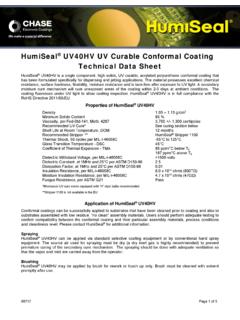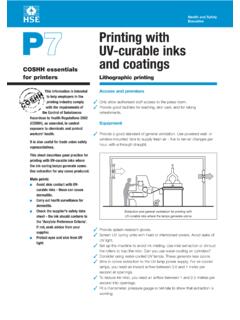Transcription of Coating Characteristics of UV Curable Epoxy …
1 Arab Journal of Nuclear Science and Applications, 47(1), (1-13) 2014 1 Coating Characteristics of UV Curable Epoxy Acrylate Oligomer Modified with Acrylated Sunflower Oil Issa M. Mousaa, Sayeda M. Ibrahim, and H. Radi Department of Radiation Chemistry, National Center for Radiation Research and Technology, 29, Naser City, Cairo, Egypt. Received: 4/4/2013 Accepted: 5/8/2013 ABSTRACT In this study Epoxy acrylate oligomer (EA) was toughened by epoxidized sunflower oil acrylate (EPOSA) and cured under UV irradiation in the presence of p-methoxy acetophenone as photointiator. EPOSA was prepared via acrylation process. Acid value, FTIR, oxirane oxygen content and viscosity were carried out to confirm the occurrence the acrylation process.
2 Different formulations of EA and EPOSA were prepared and different characterizations such as FTIR, thermogravimetric analysis (TGA), gel fraction and swelling properties were made for cured Coating films. The mechanical and chemical tests such as pencil hardness, adhesion, bending, gloss, steam and stain resistance were measured for cured surface. FTIR studies indicated that the density of acrylate functionality and degree of curing decreased with increasing the concentration of EPOSA. The elasticity, gloss and chemical resistance properties were improved by increasing the concentration of EPOSA. Key Words: UV Irradiation / Epoxy Acrylate Oligomer / Epoxidized Sunflower Oil Acrylate / Photoinititor / Adhesion / Pencil hardness.
3 INTRODUCTION UV curing process, which converts a reactive monomer into a solid through photo-polymerization and/or crosslinking reactions induced by UV radiation at room temperature (1), has attractive advantages such as rapid curing rate, solvent free, low energy requirement, and excellent properties of products (2). The UV- Curable coatings consist of oligomer, monomer and photoinitiator, so the Coating film properties, such as hardness, abrasive resistance, flexibility and weatherability, mainly depend on the oligomer structure and its concentration in the formulation. During last decades, a great deal of attentions have been paid to UV curing applications in preparing protective coatings (3), nanoimprint lithography (4),dental restoratives and adhesives (5), encapsulants and packaging of organic light-emitting devices in electronic industry (6).
4 Epoxy acrylate resin is the classic resin for UV curing coatings because of its good integrated performance such as outstanding adhesion, non-yellowing, hardness, mechanical properties and chemical resistance (7,8), and thus wide applications. Epoxy resins are widely used in several applications: adhesives, coatings, castings, electric laminates, encapsulation of semiconductor devices, matrix material for composites, structural components (9-14) and cryogenic engineering (15-17). However, due to their high cross-link density they are inherently brittle, which limits their applicability. Many efforts have been made to modify Epoxy acrylate resins or their formulations for improving the toughness of cured films.
5 To increase their toughness, different modifiers have been added like rubber, flexible components into Epoxy networks in an appropriate ratio (18-20). Aliphatic urethane acrylate or polyester acrylates are low viscosity oligomers that provide soft and flexible Coating with low shrinkage, high toughness and excellent weatherability (21). Epoxy acrylate (EA) oligomer has high viscosity at ambient temperature and diluted by the addition of low viscous multifunctional reactive monomers (22). However, these reactive diluents showed higher volatile content compared to oligomers Arab Journal of Nuclear Science and Applications, 47(1), (1-13) 2014 2 and create shrinkage and brittleness in the Coating at higher content of reactive diluents, resulting in reducing adhesion and deterioration of gloss and aesthetic look of the Coating (23-25).
6 On the other hand, epoxidized vegetable oils show excellent promise as inexpensive, renewable materials for industrial applications (26). Epoxidized sunflower oil acrylate (EPOSA) has a low viscosity oligomer with low volatile content and unique Coating properties can be used to reduce the viscosity of EA resin as well as to regulate or even improve certain properties of EA Coating by optimized combination of both the oligomers. In this study the EPOSA was prepared via acrylation process by reacting epoxidized sunflower oil and acrylic acid. The prepared EPOSA was added in different concentrations in EA formulations and cured under different times of UV radiation. EXPERIMENTAL Materials: EBECRYL 604 ( Epoxy acrylate oligomer (EA) consisting of 80% of bisphenol A Epoxy diacrylate diluted with 20% of 1,6-hexanediol diacrylate) was obtained from Cytec Surface Specialeties (Drogenbos, Belgium).
7 Epoxidized sunflower oil having oxirane oxygen content 6 % was supplied by Paint and Chemical Industry (PACHIN), Egypt. Hydroquinone, triethylamine and acrylic acid were obtained from Merck, Germany. p-methoxy acetophenone was supplied by Ciba Chemicals, Switzerland and used as a photoinitiator to initiate photochemical reaction during UV radiation process. The plywood, tin metal plate and glass samples were obtained from the local market. All chemicals were used as received without further purification Synthesis of epoxidized sunflower oil acrylate (EPOSA) (27): The acrylation of epoxidized sunflower oil was carried out by placing a mixture containing mol. epoxidized sunflower oil, hydroquinone as inhibitor and triethylamine (based on the weight of reactants) as a catalyst in a round bottom three-neck flask (500 ml).
8 The flask is equipped with a mechanical stirrer, a reflux condenser and a separating funnel. While stirring the mixture, mol. acrylic acid was introduced to the mixture through the separating funnel. After the addition of acrylic acid, the mixture was then heated up to 110oC. The progress of acrylation reaction was followed by measuring the acid value of the mixture. The product was washed with 1% NaH2PO4 and 1% NaCl to remove excess acrylic acid. Determination of acid value: The acid value was determined according to ASTM D 1639-90 as follows: Acid Value = (N x V x ) / W Where N, is the normality of KOH, V, is the volume of KOH and W, is the weight of the sample. Determination of oxirane oxygen content: The oxirane oxygen content was measured by HBr in acetic acid using crystal violet as indicator (28).
9 The oxirane oxygen content (%) was determined according to the following equation: Oxirane oxygen content (%) = [(L x N x ) / W] x100 Where L, is the volume of HBr solution, N, is the normality of HBr solution and W, is the weight of the sample. UV curing of formulations: Epoxy acrylate oligomer (EA) and acrylated sunflower oil (EPOSA) were mixed at different ratios with continuous stirring to get homogeneous mixtures to be used as formulations for Coating . Different Coating formulation samples (S0-S5) were prepared by mixing 10, 20, 30, 40, 50 phr of EPOSA with constant EA oligomer ratio of 100 phr and constant concentration of photoinitiator of Arab Journal of Nuclear Science and Applications, 47(1), (1-13) 2014 3 5%, respectively.
10 These formulations were surface coated on glass, tin metal and wood substrates by using film applicator with thickness of ~100 m. The coated samples were irradiated using a standard UV lamp Type EMITA VP-60 (made in Poland), 180W mercury, 220V, 50 Hz and monochromatic filter ( =320 nm) was used to provide the required irradiation wavelength. In this study, the UV irradiation was carried out, in which the sample was placed at a constant distance (10 cm) from the lamp for various time intervals at a dose rate of KJ/m2. Fourier Transform infrared spectroscopy (FT-IR): IR spectra of cured films were measured by ATI Mattson, Genesis series, England. FTIR spectra were recorded in the range from 400 to 4000 cm 1 with a resolution of 4 cm 1 and averaged over 25 scans.







